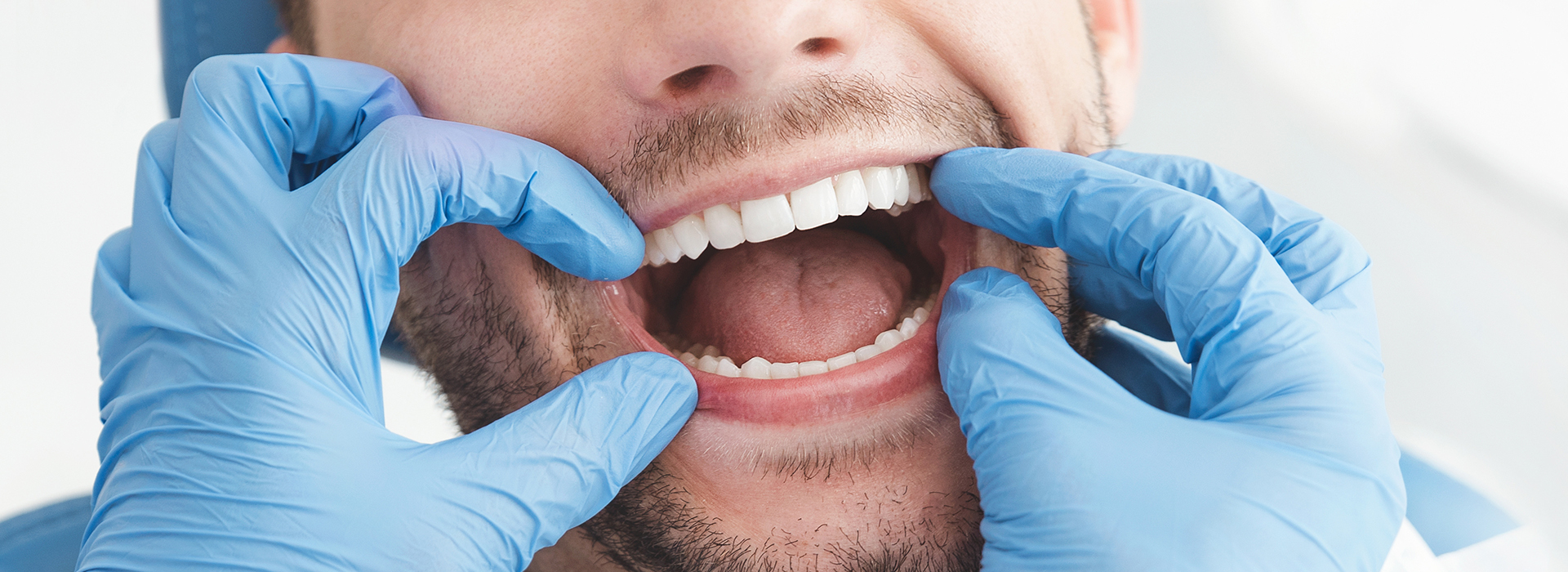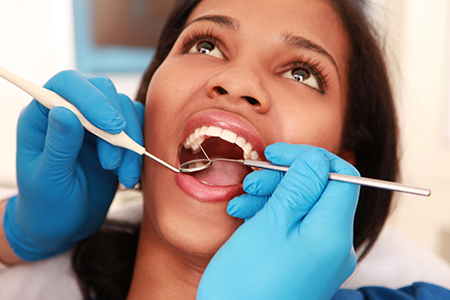Existing Patients
(515) 223-4194
New Patients
(515) 207-7409

At the office of Smiles for Life, we take a forward-thinking approach to oral health because prevention is the most powerful tool we have. Regular oral exams give our clinicians a chance to identify early signs of trouble, reinforce healthy habits, and tailor care to each patient's needs. During these visits you can expect a full review of your medical background, a careful inspection of teeth and soft tissues, and guidance on maintaining a resilient, attractive smile. Our preventive services include comprehensive exams, professional cleanings, and routine oral cancer screenings, paired with clear, practical education about daily care.
Your initial oral exam is designed to establish a detailed baseline for your dental health and to help us understand your priorities. We start by reviewing your medical and dental histories, along with any medications or symptoms you may be experiencing. That context helps us spot risk factors that can influence oral conditions and guide our examination focus.
Next comes the clinical portion: a careful inspection of the teeth, gums, oral tissues, and the surrounding head and neck structures. We look for cavities, early gum disease, signs of clenching or grinding, and any unusual lesions that warrant further evaluation. Function is part of the assessment too — we check your bite and the temporomandibular joint for signs of stress or dysfunction.
Diagnostic imaging is ordered only when it will add meaningful insight. Digital x-rays reveal hidden decay, bone levels around teeth, and other issues not visible to the naked eye. At the end of the visit we’ll review findings, answer your questions, and outline possible next steps so you leave with a clear understanding of your oral health and any recommended care.

The condition of your mouth can offer important clues about overall health. Changes in gum tissue, persistent dry mouth, unusual sores, or chronic bad breath can sometimes reflect medical issues that extend beyond the teeth — from metabolic conditions to immune-related concerns. During an exam we pay attention to these signs and discuss any observations that may warrant medical follow-up.
Growing research underscores connections between oral inflammation and systemic health. While oral problems don’t cause every illness, untreated dental disease can add to the body’s inflammatory burden and complicate other conditions. That’s why routine oral exams are an important part of preventive health and coordination with other healthcare providers when appropriate.
Because many systemic conditions first manifest in the mouth, we remain vigilant for red flags that might benefit from additional medical evaluation. When concerns arise, we communicate clearly about what we’ve found, why it matters, and what steps — dental or medical — make sense next.

Consistent checkups and professional cleanings are the backbone of lasting oral health. Plaque and tartar that build up over time create the environment for cavities and gum disease; a thorough hygienist visit removes those deposits and reduces the bacterial load that drives decay and inflammation. Beyond cleaning, these visits allow us to monitor trends in your mouth and intervene early when problems begin.
Good oral health also depends on daily habits. During your appointment we’ll review brushing and flossing technique, suggest tools or products that fit your routine, and help you set attainable goals. Education is always tailored — what helps one patient may not be ideal for another — so our recommendations reflect your needs, dexterity, and lifestyle.
Children and adolescents benefit greatly from regular preventive care that builds healthy habits from the start. We track growth and tooth development and can advise when an orthodontic evaluation might be appropriate. For adults, routine visits are an opportunity to reassess risks like gum recession, enamel wear from grinding, and the effects of medications that cause dry mouth.
At Smiles for Life, our aim is to make preventive care approachable and effective: practical guidance, consistent monitoring, and timely intervention keep small problems from becoming larger ones.
Visual inspection is essential, but many dental conditions lie beneath the surface. Dental x-rays — especially in their modern, digital form — allow us to see the hidden anatomy of teeth, roots, and supporting bone. These images are an important part of a comprehensive exam and are chosen selectively to answer specific clinical questions.
Digital radiography has several advantages. Images appear instantly, which makes it easier to explain findings during your visit. Digital sensors typically require less radiation than older film techniques and eliminate the need for developing chemicals, reducing environmental impact. Digital files can also be securely stored and shared with specialists when collaborative care is needed.
X-rays help detect early cavities between teeth, assess bone levels in cases of gum disease, locate root fragments or impacted teeth, and evaluate the health of the jaw when pain or swelling is present. When advanced three-dimensional detail is required, cone-beam computed tomography (CBCT) provides precise anatomical information for diagnosis and treatment planning.

Different radiographic views serve different diagnostic roles. Small periapical images focus on an individual tooth from crown to root and are valuable for spotting root problems or localized infection. Bitewing images capture the upper and lower crowns in a single area and are especially useful for detecting early decay between teeth.
A full-mouth series combines periapical and bitewing images to document the condition of all teeth and surrounding bone. Panoramic films (panorex) provide a broad, two-dimensional view of the jaws and are helpful for assessing overall development, impacted teeth, and the general condition of the jawbone. Cephalometric films offer a profile view commonly used in orthodontic assessment and planning.
For complex cases — such as planning implant placement or evaluating anatomy before oral surgery — three-dimensional CBCT scans give a detailed map of bone structures and nerve pathways. Your clinician will recommend the imaging type that best addresses your diagnostic needs while keeping exposure and convenience in mind.
Routine oral exams are an opportunity to protect your smile and to detect issues before they become more involved. They combine careful clinical inspection, targeted imaging, professional hygiene, and clear patient education to support lasting oral and overall health. If you have questions about what to expect during an exam or how often you should be seen, please contact us for more information.
Yes. We always welcome new patients and their families for care. Feel free to give us a call or reach out to us online to schedule a first visit or for any additional information on our office. We look forward to hearing from you!
Routine dental checkups and professional cleanings help ensure your smile remains in tip-top condition and that any developing problems receive the prompt care they require. While it's a good idea to schedule a checkup and cleaning twice a year, longer or shorter intervals between routine visits depend on your specific needs.
We understand that life gets complicated and busy, and for various reasons, you haven't been able to get to the dentist for care. Don't worry; it's always a good time to get back in touch with the health of your smile.
At Smiles for Life, we offer skilled and compassionate care to address a wide range of dental needs. Whether you need a simple checkup and cleaning, restorations, periodontal treatment, root canal therapy, or the replacement of missing teeth to get your smile back into shape, we provide precise, gentle, stress-free treatment to give you a smile that is as beautiful as it is healthy.
Give us a call today; we're happy to address all your questions and concerns about getting your smile back in tip-top condition.
For pregnant women, practicing good oral care and seeing the dentist to maintain a healthy smile is considered an important component of prenatal care. Researchers have found that pregnancy not only increases the risk of oral health problems, but these problems may also lead to pregnancy complications. At the office of Smiles for Life, we provide the skilled and compassionate care required to help expectant mothers keep their teeth and gums in tip-top condition. While certain procedures are not recommended during pregnancy, we provide the necessary care and take all the necessary precautions required.
Thanks to advances in modern dentistry, teeth that have been affected by a range of imperfections or that have sustained damage from trauma or dental decay can be restored to produce a naturally beautiful looking and functional smile.
As skilled and experienced providers of care, our office can effectively improve and enhance the appearance of teeth that are stained, discolored, misshapen, chipped, fractured, gapped, crowded, or broken down due to dental decay. At the office of Smiles for Life, we offer a comprehensive selection of the leading-edge cosmetic solutions from teeth whitening procedures, dental bonding, tooth-colored fillings, and veneers, to prosthetic solutions and dental implants to rebuild complete and beautiful smiles.
Contact our office to learn more about the many ways we can help you create the smile you've always wanted.
If you're visiting Smiles for Life for the first time, it is helpful that you contact your former dental office and have your records sent over to us. Make note of any problems you may have so that you can discuss them with your dentist.
To provide efficient service, we ask you to please bring your insurance card, an ID, plus any referral slips or diagnostic records given to you by another office. If you are taking medications, please note or make a list of what they are as you will need to provide that information.
Yes! We assure you that both you and your family will be in good hands at the office of Smiles for Life.
We do our best to make sure every patient who steps into our office for care is put at ease. We provide precise and gentle care and our skilled, compassionate team strives to make every visit stress-free. You can rest assured that your smile is in the best of hands and that we are doing all we can to ensure your comfort throughout every procedure. While we always take the time to explain every step in care, feel free to ask us any questions about local anesthesia and methods of dental sedation.
At the office of Smiles for Life, we strive to provide the highest quality of care to address all your dental needs. Once we've had the opportunity to examine your smile, we can give you a clear picture of any dental issues that are present, along with a quote for what the cost of treatment will be. The cost of care all depends upon the extent and complexity of issues affecting the health or appearance of your smile and the types of procedures that are required. Our goal is to make dental care more affordable so that you can begin treatment without any additional stress or delay.
Keep in mind that with routine dental checkups and periodic care, we can help prevent dental disease while treating emerging problems early in their onset to avoid larger issues and more expensive care down the road.
Routine dental checkups and preventive care procedures may be covered under your dental insurance plan requiring little to no out-of-pocket expense. We invite you to check our financial information page or give us a call to find out if our office participates with your plan, and if you have any other questions about dental insurance, dental savings plans, forms of payment, or financing options. We welcome your inquiries and do our best to help you begin care without additional stress or delay.
If you've lost a tooth due to injury, decay, gum disease, or any other reason, we recommend dental implants to replace missing teeth. Dental implants come the closest to replicating the look, feel, and function of your natural teeth.
Absolutely! Both flossing and brushing regularly are equally important to maintain your oral health. While brushing cleans the surface of your teeth, flossing cleans in between them. Flossing is important to prevent plaque buildup, which can cause gums to recede and lead to periodontal disease.
Even if you have dentures, it is still necessary to see a dentist! Dental checkups help ensure that your dentures are comfortable, fitting properly, and that there are no other problems. Beyond assessing your dentures, our dentist will also perform a thorough examination of the jawbone, and surrounding soft tissues both inside the mouth, the face, and neck, to confirm that you remain in good oral health.
Emergency dental care is a service we hope you'll never need- but if you do, the office of Smiles for Life is here for you!
Whether you're suffering from a chipped tooth, toothache, or any problem affecting your oral health, you can be sure to get the prompt attention and compassionate care you require at our office. Patient care and comfort are our top priorities, and we offer a comprehensive range of the most advanced services to address a broad spectrum of dental needs.
While the pain of a toothache is one of the more common reasons that patients come to our office for emergency dental care, we also promptly treat emergencies that are not necessarily painful like crowns that have been dislodged and broken dentures that leave embarrassing gaps in one's smile.
You can rest assured that your oral health is in the best of hands at our office. We'll quickly determine exactly what's wrong, explain your treatment options, and then provide the precise and gentle care you require to alleviate your discomfort and get you back on the path to oral health and wellness.
Your health and comfort are our top priorities. If your dental emergency is painful, if it affects the appearance of your smile, or if you suspect that an infection is present, our office will make every effort to see you as soon as possible for care.
At the office of Smiles for Life, we welcome patients of all ages for care and offer a comprehensive range of services designed to help every member of your family maintain a beautiful and healthy smile. Whether you or a loved one needs a routine checkup and cleaning, fillings, same-day crowns, a cosmetic smile makeover, the replacement of missing teeth or require the services of a skilled and compassionate emergency dentist, you can rely on our office for the highest quality care.
For more information on our office and the many services we provide, or to schedule an appointment for care, give us a call today.
An oral exam is a clinical evaluation of the teeth, gums, soft tissues and surrounding structures that helps clinicians identify current concerns and potential risks. The exam typically includes a review of your medical and dental history, a visual and tactile inspection of the mouth, and targeted questions about symptoms such as pain, sensitivity or changes in appearance. By combining observation, patient history and selective diagnostic tools, an exam gives a clear picture of oral health and informs prevention and treatment planning.
Regular oral exams are a cornerstone of preventive care because they let clinicians catch problems early, when treatment is simpler and more effective. Exams also provide an opportunity to reinforce daily hygiene habits and to discuss lifestyle factors that affect oral health. When problems are detected early, the likelihood of preserving natural teeth and avoiding more invasive procedures increases significantly.
Your first comprehensive assessment establishes a baseline for future care and helps the team understand your priorities and risks. Expect a detailed review of medical history, medications and any symptoms, followed by a thorough clinical exam of teeth, gums, oral mucosa and head and neck structures to check for decay, gum disease, lesions or functional concerns. Function is also evaluated by assessing your bite, jaw movement and the temporomandibular joint for signs of stress or dysfunction.
Diagnostic imaging is used selectively to reveal issues that are not visible during a visual exam, and the clinician will explain why any x-rays are recommended. At the end of the visit you will receive a summary of findings, answers to your questions and a recommended plan for preventive care or follow-up treatment. The office of Smiles for Life focuses on clear communication so you leave with an actionable understanding of your oral health status.
The mouth often reflects broader health conditions, and careful oral exams can reveal signs that warrant medical attention. Changes in gum tissue, persistent dry mouth, unusual sores, chronic bad breath or rapid oral tissue changes may indicate systemic concerns such as metabolic disorders, autoimmune conditions or side effects of medications. Clinicians document these findings and discuss them with patients so appropriate medical follow-up can be pursued when necessary.
While an oral exam does not diagnose systemic disease, it contributes important information to a patient’s overall health picture and supports coordination with other healthcare providers. Early recognition of oral manifestations can lead to timelier medical evaluations and integrated care. Communication and timely referrals help ensure that oral findings are evaluated in the context of each patient’s general health.
Dental x-rays supplement the clinical exam by revealing anatomy that cannot be seen visually, such as interproximal decay, root conditions and bone levels around teeth. Modern digital radiography provides high-resolution images quickly and with lower radiation exposure than traditional film, allowing clinicians to explain findings during the appointment. X-rays are ordered only when they will provide diagnostic value and guide treatment decisions.
For complex cases where three-dimensional detail is needed — for example implant planning, assessment of impacted teeth or evaluation of jaw pathology — cone-beam computed tomography (CBCT) offers precise anatomical information. Your clinician will recommend the imaging modality that best addresses the clinical question while keeping exposure and patient comfort in mind. Images can also be securely shared with specialists when collaborative care is required.
Frequency of exams and cleanings varies according to individual risk factors such as personal oral hygiene, history of gum disease, decay risk, systemic health conditions and tobacco use. Many patients benefit from exams and professional cleanings every six months, while others with elevated risk may require more frequent visits to manage inflammation, monitor progression or adjust preventive strategies. The clinician will recommend a schedule tailored to your specific needs.
Routine visits are an opportunity to remove plaque and tartar, monitor trends in oral health and intervene early when problems begin. Consistent preventive care reduces the chance that minor issues will progress to more complex treatments. Your recommended recall interval can change over time as your oral health and risk profile evolve, so regular reassessment is important.
Oral exams are tailored to a patient’s stage of growth and specific risks: for children the focus includes eruption patterns, space management and early habit counseling, while adolescent exams often address orthodontic indicators and preventive sealants. For adults the exam frequently emphasizes periodontal health, restorative needs and monitoring of wear from grinding or acid exposure. Each life stage has unique priorities, and exams are structured to address those priorities effectively.
Pediatric exams also include age-appropriate education for parents and children about brushing, flossing and diet to establish healthy habits early. Teen and adult visits incorporate discussions about factors such as tobacco, alcohol, medications and chronic medical conditions that can affect oral health. The goal is to provide developmentally appropriate care that supports long-term dental wellness across the lifespan.
Oral cancer screening is a routine part of comprehensive exams and involves a visual and tactile inspection of the lips, oral mucosa, tongue, floor of mouth, and oropharynx to detect any unusual lumps, red or white patches, or persistent sores. The clinician palpates the neck and lymph nodes to check for abnormal enlargement and assesses any areas of concern for texture or induration. Findings are documented and communicated clearly so patients understand what was observed and why further evaluation may be recommended.
If the clinician identifies a suspicious lesion, they will discuss next steps which may include short-term monitoring, referral for biopsy or collaboration with a specialist. Early detection significantly improves outcomes, so routine screening is an important preventive measure. Smiles for Life integrates oral cancer screening into regular exams to support timely identification and follow-up when needed.
Assessment for bruxism and temporomandibular joint (TMJ) disorders includes inspection for enamel wear, fractures, tooth mobility, and muscle tenderness, as well as evaluation of jaw range of motion and joint sounds. The clinician asks about symptoms such as morning headaches, jaw pain, sleep disturbances and tooth sensitivity to identify patterns that suggest grinding or dysfunction. Together these observations help determine whether conservative management or further investigation is warranted.
Management strategies often begin with conservative measures like behavioral modification, nightguards to protect tooth structure, and referral to appropriate specialists when necessary. If structural or functional problems are identified, the care plan may evolve to include occlusal adjustments, physical therapy or coordinated care with medical providers. Regular monitoring during routine exams ensures that interventions are adjusted as the patient’s needs change.
Preparing for an oral exam is straightforward and helps the clinician deliver the most effective care: bring a current list of medications, note any recent medical changes or symptoms, and be ready to discuss dental history and personal oral hygiene habits. If you have recent imaging or records from another provider, bring them or arrange to have them transferred, as previous information can be valuable for comparison. Arriving with questions or concerns written down ensures you address what matters most to you during the visit.
If you have specific symptoms such as pain, swelling or a sore that does not heal, mention these when you call to schedule and again at check-in so the team can prioritize appropriate evaluation. For patients with anxiety, mobility limitations or special needs, letting the office know ahead of time allows staff to plan accommodations that improve comfort and access. Open communication and preparation make the appointment more efficient and productive.
If a concern is identified during an exam, the clinician will explain the finding, its significance and recommended next steps in clear, patient-centered terms. Options may include additional diagnostic imaging, a targeted cleaning, short-term monitoring, noninvasive therapy or referral to a specialist for further evaluation or treatment. The emphasis is on choosing an appropriate, evidence-based plan that addresses the issue while considering the patient’s overall health and preferences.
Follow-up appointments or referrals are scheduled as needed to resolve the concern or to initiate definitive care, and clinicians document findings so progress can be tracked over time. Patient education is integral to this process; understanding the rationale for recommended steps helps patients make informed choices and participate actively in their care. Ongoing monitoring at routine exams ensures that any changes are caught early and managed effectively.